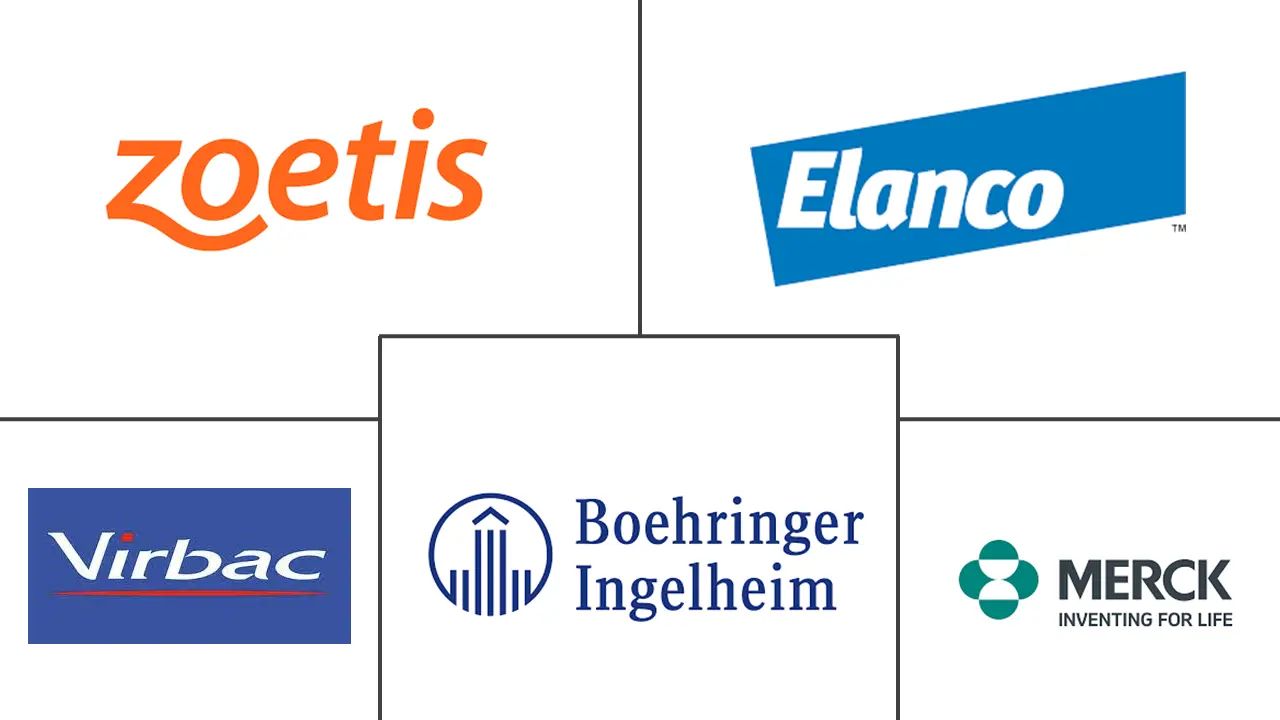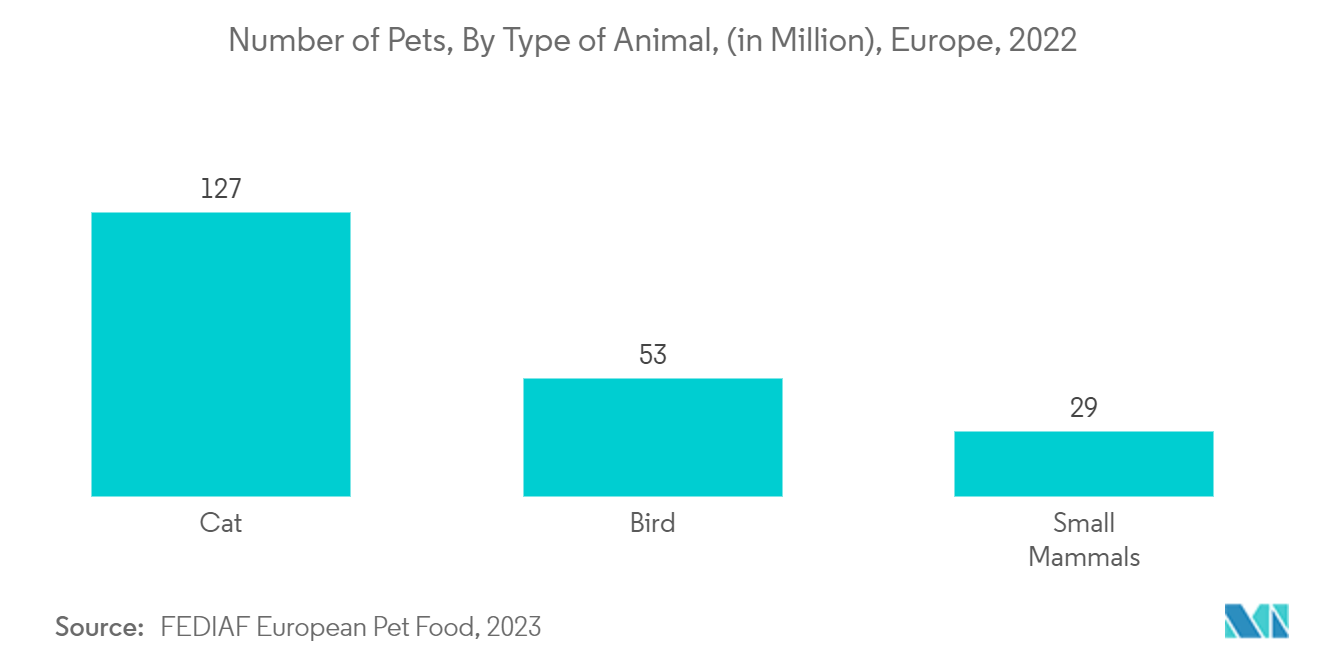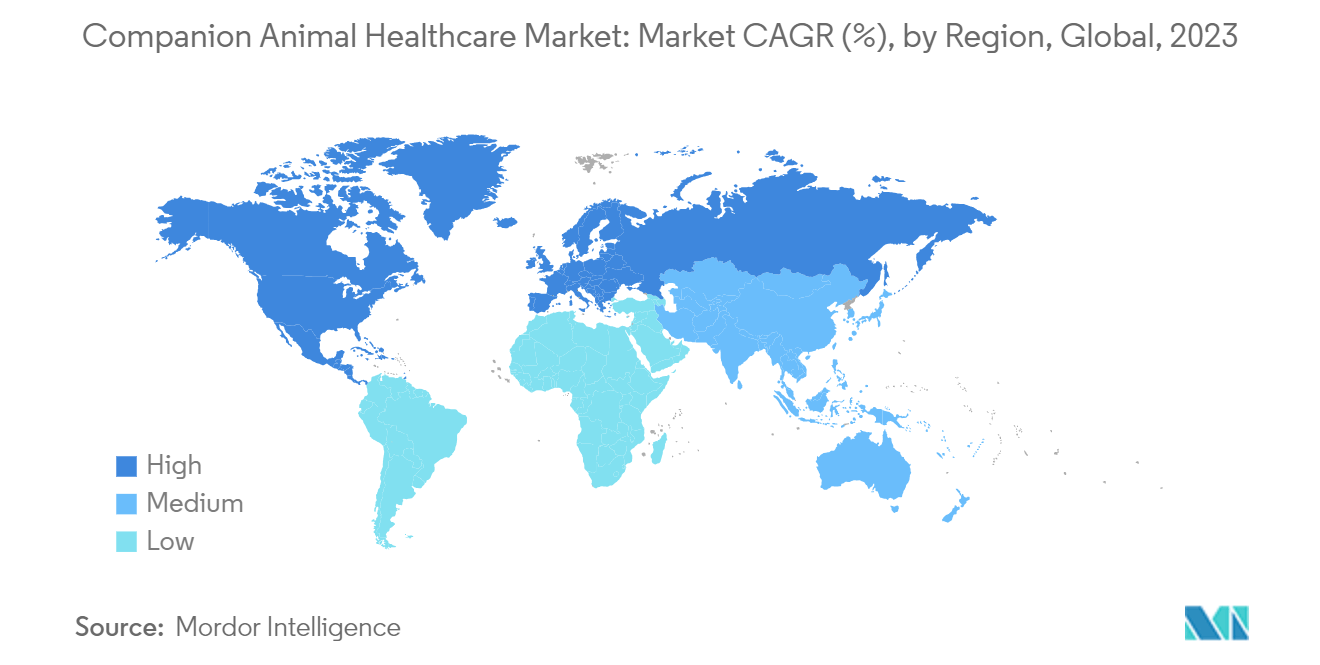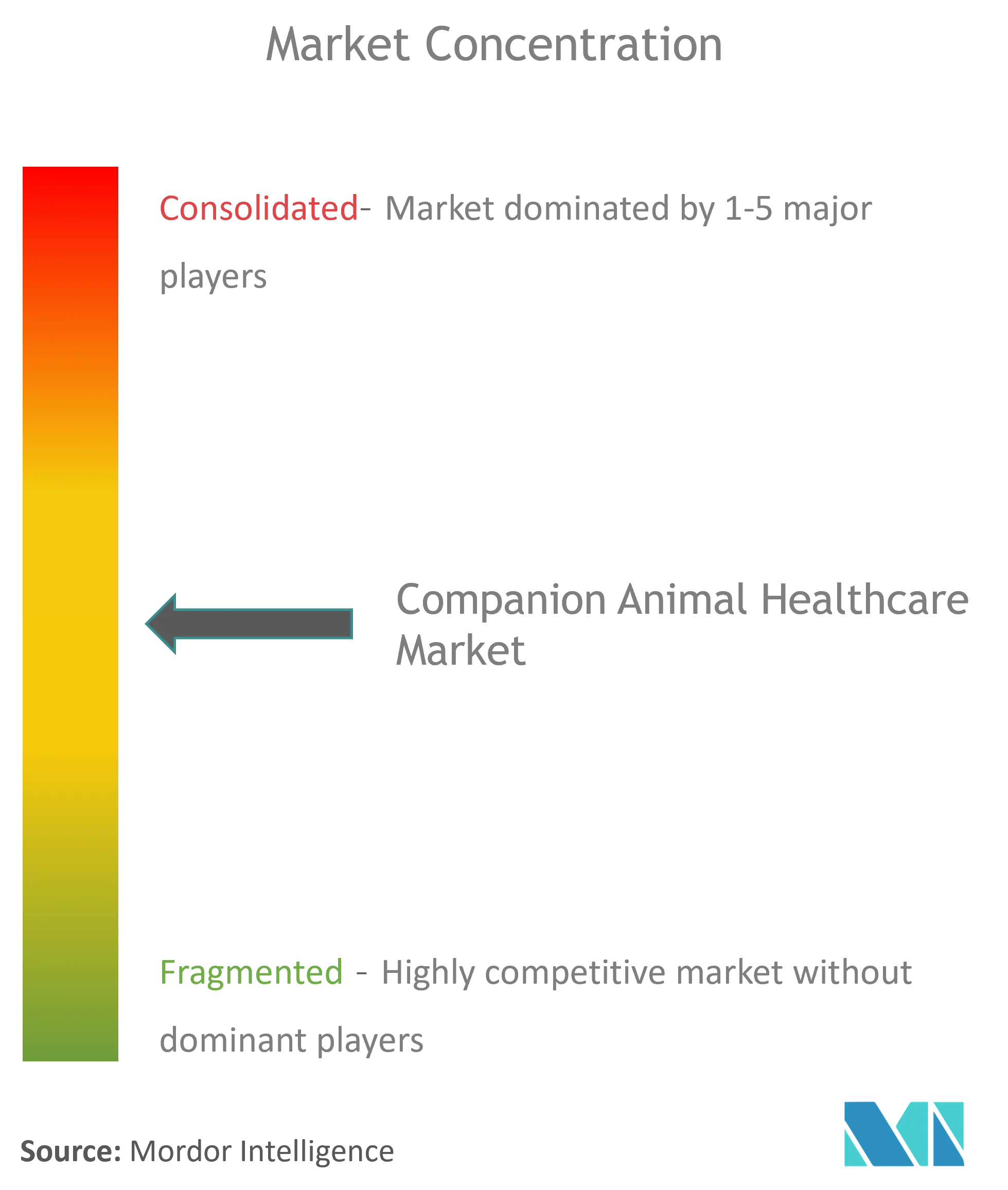Companion Animal Healthcare Market Size

| Study Period | 2019 - 2029 |
| Market Size (2024) | USD 17.90 Billion |
| Market Size (2029) | USD 27.57 Billion |
| CAGR (2024 - 2029) | 9.03 % |
| Fastest Growing Market | Asia Pacific |
| Largest Market | North America |
Major Players
*Disclaimer: Major Players sorted in no particular order |
Companion Animal Healthcare Market Analysis
The Companion Animal Healthcare Market size is estimated at USD 17.90 billion in 2024, and is expected to reach USD 27.57 billion by 2029, growing at a CAGR of 9.03% during the forecast period (2024-2029).
Several factors contribute to the growth of the companion animal healthcare market, including the rise in pet adoption, increasing government and animal welfare initiatives, and advancements in animal healthcare technology.
The increase in remote work arrangements has led to a surge in pet adoption as people seek companionship to cope with depression and anxiety resulting from social distancing measures. For example, data from the European Pet Food Industry: Facts and Figures 2023 report states that Europe had around 340 million companion animals, with approximately 46% of households owning at least one pet in 2022. In Germany, for instance, there were approximately 10.6 million pet dogs and 15.2 million pet cats in 2022, indicating a higher adoption rate for cats compared to dogs.
The growing incidence of cancer, particularly in dogs, is expected to drive market growth. Research from the Royal Veterinary College (RVC) published in June 2023 highlighted the prevalence and risk factors for osteosarcoma, a type of bone cancer, across different dog breeds in the United Kingdom. This underscores the need for health initiatives, especially for cancer treatment, supported by both government and private organizations.
Additionally, the growing ownership of pets has spurred strategic initiatives by the companies to enhance their market presence in animal healthcare. For instance, in November 2023, Inspire Veterinary Partners acquired Valley Veterinary Service Inc. in Pennsylvania, United States. Through this acquisition, the company entered the state with its first center. These strategic initiatives are expected to increase the accessibility of advanced pet healthcare centers, thereby fueling market growth.
Thus, the market is expected to witness significant growth owing to the increasing adoption rate of pets, coupled with enhancement in research and development. However, challenges such as the use of counterfeit medicines and rising costs of animal testing and veterinary care may impede the growth of the companion animal healthcare market over the forecast period.
Companion Animal Healthcare Market Trends
The Vaccines Segment is Expected to Witness Significant Growth Over the Forecast Period
The vaccines segment is poised for substantial growth in the companion animal healthcare market in the coming years, driven by various factors. These include the increasing prevalence of zoonotic and chronic diseases, a surge in product launches, increasing awareness of animal health, growing investments by government bodies and associations, and a rise in healthcare expenditure for companion animals.
Vaccines consist of viruses, bacteria, or other disease-causing agents that have been modified to enhance immunity without causing illness. Advanced vaccines now incorporate genetically engineered components derived from these disease agents.
The proliferation of initiatives by veterinary clinics worldwide to promote vaccination is a key driver of market growth. For example, in March 2024, Bernalillo County Animal Care Services organized a drive-thru vaccine and microchip clinic offering free services for cats and dogs. Vaccination is crucial for companion animals, not only protecting them from epidemics but also safeguarding owners in the event of animal bites.
Market players are actively developing and introducing new vaccines globally to strengthen their market presence, further bolstering segment growth. For instance, in November 2023, the Animal and Plant Health Inspection Service of the US Department of Agriculture awarded the University of Wisconsin School of Veterinary Medicine USD 3.7 million to develop vaccines targeting mitigating or preventing the impact of future disease outbreaks that can spread between animals and humans. One such project is the Universal Mucosally Administered SARS-CoV-2 vaccine for animals, which aims to identify effective interventions to prevent transmission of SARS-CoV-2 and mitigate potential impacts on the food supply.
In September 2022, Merck Animal Health donated approximately five million doses of its NOBIVAC rabies vaccine on World Rabies Day to help eliminate canine-mediated rabies. Through its Afya Program, Merck provided these vaccines to partners such as Mission Rabies and Rabies Free Africa, who administer them to dogs through mass vaccination campaigns worldwide. Such developments contribute significantly to market growth.
The vaccines segment of the companion animal healthcare market is expected to experience substantial growth during the forecast period due to the aforementioned factors.

North America Dominates the Market, and This Trend is Expected to Continue Over the Forecast Period
North America is projected to lead the companion animal healthcare market in the future, driven by several factors. These include the increasing adoption of companion animals, growing awareness among pet owners regarding pet healthcare and available services, and the presence of key market players in the region.
The growing pet population and rising expenditure on pet care are key drivers of market expansion. For example, according to Pet Ownership Statistics 2024 by Forbes Media LLC, as of 2024, 66% of US households (86.9 million homes) own a pet. Dogs are the most adopted pets in the United States., with 65.1 million households owning a dog, followed by cats (46.5 million households) and freshwater fish (11.1 million households) in 2022.
Similarly, data published by Pangolia Pte. Ltd in May 2024 indicated that nearly 8.5 million cats were owned by Canadian households, while 7.9 million dogs were owned by them in 2022. Furthermore, Canadian pet owners are willing to invest in their pets' healthcare, with an average spending of USD 2,800 on cats and USD 3,999 on dogs. The heightened awareness among pet owners regarding pet healthcare is expected to drive the demand for available products and services.
Ongoing research and development for therapeutic products and technological advancements in companion animal healthcare further contribute to market growth in the region. For instance, in May 2022, Jaguar Health Inc. launched the Canine Cancer: Take CHARGE (Canine Health And ReGistry Exchange), a national Canine Cancer Registry and Canine Cancer Care Index aimed at providing valuable incidence and prevalence data to the veterinary community and pet owners to guide canine cancer diagnosis and treatment decisions.
The companion animal healthcare market in North America is poised for growth in the forecast period, supported by the factors mentioned above.

Companion Animal Healthcare Industry Overview
The market for companion animal healthcare is consolidated and dominated by a few players, such as Elanco, Zoetis Animal Healthcare, Ceva Sante Animale, Merck, Virbac, and Boehringer Ingelheim Animal Health. These global players hold the largest share of the market through various strategies, such as product development and mergers and acquisitions.
Companion Animal Healthcare Market Leaders
-
Elanco
-
Boehringer Ingelheim Animal Health
-
Virbac
-
Zoetis Animal Healthcare
-
Ceva Sante Animale
*Disclaimer: Major Players sorted in no particular order

Companion Animal Healthcare Market News
- March 2024: HawkCell, a France-based startup, raised EUR 5 million (USD 5.44 million) in funding to develop AI-based imaging for veterinary applications and enhance preclinical research in animal healthcare.
- August 2023: Akston Biosciences Corporation announced its commitment to the invention, development, and production of innovative protein therapeutics for Companion Animal Health. The company planned to leverage its versatile Ambifect Fc-fusion platform and its cGMP biologics manufacturing facility in Massachusetts, United States, for this purpose.
Companion Animal Healthcare Market Report - Table of Contents
1. INTRODUCTION
- 1.1 Study Assumptions and Market Definition
- 1.2 Scope of the Study
2. RESEARCH METHODOLOGY
3. EXECUTIVE SUMMARY
4. MARKET DYNAMICS
- 4.1 Market Overview
-
4.2 Market Drivers
- 4.2.1 Increase in Pet Adoption
- 4.2.2 Rise in the Number of Initiatives by Governments and Animal Welfare Associations
- 4.2.3 Advanced Technology in Animal Healthcare
-
4.3 Market Restraints
- 4.3.1 Use of Counterfeit Medicines
- 4.3.2 Increasing Costs of Animal Testing and Veterinary Care
-
4.4 Porter's Five Forces Analysis
- 4.4.1 Threat of New Entrants
- 4.4.2 Bargaining Power of Buyers/Consumers
- 4.4.3 Bargaining Power of Suppliers
- 4.4.4 Threat of Substitute Products
- 4.4.5 Intensity of Competitive Rivalry
5. MARKET SEGMENTATION (Market Size by Value - USD)
-
5.1 By Product Type
- 5.1.1 By Therapeutics
- 5.1.1.1 Vaccines
- 5.1.1.2 Parasiticides
- 5.1.1.3 Anti-Infectives
- 5.1.1.4 Medical Feed Additives
- 5.1.1.5 Other Therapeutics
- 5.1.2 By Diagnostics
- 5.1.2.1 Immunodiagnostic Tests
- 5.1.2.2 Molecular Diagnostics
- 5.1.2.3 Diagnostic Imaging
- 5.1.2.4 Other Diagnostics
-
5.2 By Animal Type
- 5.2.1 Dogs
- 5.2.2 Cats
- 5.2.3 Other Companion Animals
-
5.3 Geography
- 5.3.1 North America
- 5.3.1.1 United States
- 5.3.1.2 Canada
- 5.3.1.3 Mexico
- 5.3.2 Europe
- 5.3.2.1 Germany
- 5.3.2.2 United Kingdom
- 5.3.2.3 France
- 5.3.2.4 Italy
- 5.3.2.5 Spain
- 5.3.2.6 Rest of Europe
- 5.3.3 Asia-Pacific
- 5.3.3.1 China
- 5.3.3.2 Japan
- 5.3.3.3 India
- 5.3.3.4 Australia
- 5.3.3.5 South Korea
- 5.3.3.6 Rest of Asia-Pacific
- 5.3.4 Middle East & Africa
- 5.3.4.1 GCC
- 5.3.4.2 South Africa
- 5.3.4.3 Rest of Middle East & Africa
- 5.3.5 South America
- 5.3.5.1 Brazil
- 5.3.5.2 Argentina
- 5.3.5.3 Rest of South America
6. COMPETITIVE LANDSCAPE
-
6.1 Company Profiles
- 6.1.1 Elanco Animal Health
- 6.1.2 Boehringer Ingelheim Animal Health
- 6.1.3 Virbac
- 6.1.4 Brilliant Bio Pharma
- 6.1.5 Zoetis Inc.
- 6.1.6 Phibro Animal Health Corporation
- 6.1.7 IDEXX LABORATORIES INC
- 6.1.8 Merck & Co. Inc.
- 6.1.9 Norbrook
- 6.1.10 Ceva Sante Animale
- *List Not Exhaustive
7. MARKET OPPORTUNITIES AND FUTURE TRENDS
** Subject To AvailablityCompanion Animal Healthcare Industry Segmentation
As per the scope of the report, companion animals provide companionship to human beings, as well as guard their houses and offices. Various types of diseases in animals have increased the demand for vaccines and diagnostic tests. This surge in demand is primarily due to the need to treat and cure the diseases associated with the health of pets.
The companion animal healthcare market is segmented by product, animal type, and geography. By product, the market is segmented into therapeutics and diagnostics. By therapeutics, the market is sub-segmented into vaccines, parasiticides, anti-infectives, medical feed additives, and other therapeutics. By diagnostics, the market is sub-segmented into immunodiagnostic tests, molecular diagnostics, diagnostic imaging, and other diagnostics. By animal type, the market is segmented into dogs, cats, and other animal types. By geography, the market is segmented into North America, Europe, Asia-Pacific, Middle East & Africa, and South America. The report also covers the estimated market sizes and trends for 17 different countries across major regions globally. For each segment, the market sizing and forecasts were made on the basis of revenue (USD).
| By Product Type | By Therapeutics | Vaccines |
| Parasiticides | ||
| Anti-Infectives | ||
| Medical Feed Additives | ||
| Other Therapeutics | ||
| By Product Type | By Diagnostics | Immunodiagnostic Tests |
| Molecular Diagnostics | ||
| Diagnostic Imaging | ||
| Other Diagnostics | ||
| By Animal Type | Dogs | |
| Cats | ||
| Other Companion Animals | ||
| Geography | North America | United States |
| Canada | ||
| Mexico | ||
| Geography | Europe | Germany |
| United Kingdom | ||
| France | ||
| Italy | ||
| Spain | ||
| Rest of Europe | ||
| Geography | Asia-Pacific | China |
| Japan | ||
| India | ||
| Australia | ||
| South Korea | ||
| Rest of Asia-Pacific | ||
| Geography | Middle East & Africa | GCC |
| South Africa | ||
| Rest of Middle East & Africa | ||
| Geography | South America | Brazil |
| Argentina | ||
| Rest of South America |
Companion Animal Healthcare Market Research FAQs
How big is the Companion Animal Healthcare Market?
The Companion Animal Healthcare Market size is expected to reach USD 17.90 billion in 2024 and grow at a CAGR of 9.03% to reach USD 27.57 billion by 2029.
What is the current Companion Animal Healthcare Market size?
In 2024, the Companion Animal Healthcare Market size is expected to reach USD 17.90 billion.
Who are the key players in Companion Animal Healthcare Market?
Elanco, Boehringer Ingelheim Animal Health, Virbac, Zoetis Animal Healthcare and Ceva Sante Animale are the major companies operating in the Companion Animal Healthcare Market.
Which is the fastest growing region in Companion Animal Healthcare Market?
Asia Pacific is estimated to grow at the highest CAGR over the forecast period (2024-2029).
Which region has the biggest share in Companion Animal Healthcare Market?
In 2024, the North America accounts for the largest market share in Companion Animal Healthcare Market.
What years does this Companion Animal Healthcare Market cover, and what was the market size in 2023?
In 2023, the Companion Animal Healthcare Market size was estimated at USD 16.28 billion. The report covers the Companion Animal Healthcare Market historical market size for years: 2019, 2020, 2021, 2022 and 2023. The report also forecasts the Companion Animal Healthcare Market size for years: 2024, 2025, 2026, 2027, 2028 and 2029.
Companion Animal Healthcare Industry Report
Statistics for the 2024 Companion Animal Healthcare market share, size and revenue growth rate, created by Mordor Intelligence™ Industry Reports. Companion Animal Healthcare analysis includes a market forecast outlook to 2029 and historical overview. Get a sample of this industry analysis as a free report PDF download.



